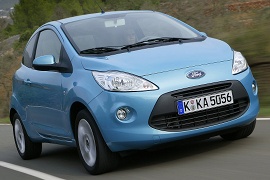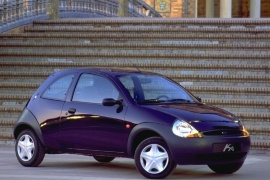FORD Ka Models/Series Timeline, Specifications & Photos
First production year: 1997
Engines: Gasoline, Diesel
Body style: Hatchback
Ford developed the Ka in a joint-project alongside the Italian car-maker Fiat. But the result was far from what was expected.
The Ka was built in Poland at Fiat's factory on the same assembly line with the 500, Panda, and the Lancia Ypsilon. In October 2008, at the Paris Motor Show, Ford introduced it while the world financial crisis was shaking the automotive industry. Ford needed a car that could sell in big numbers to compensate for other blue-oval brands' financial loss. It was kept on the market for almost eight years, but it was discontinued afterward on the European continent.
The design was a blend of curved lines combined in angles that made the car looks bigger. The hood was short, and the greenhouse was tall to make room for four adults. It was hard to hide that the vehicle had less than 12 ft (3.6 m) long. The three-door hatchback was fit for crowded cities, and the tall bumpers were designed to reduce the repair costs due to light parking scratches.
The Ford designers installed a two-tone dashboard to improve the car's appeal in front of the customers. With its friendly dashboard and high-mounted gear stick, Ford addressed the car to those who needed a car for the urban commute. In the back, there was hardly room for three adults. The rear bench seatback was folding to expand the, otherwise, small trunk.
While Fiat installed its 1.4-liter gasoline unit, Ford kept the 1.2-liter version and took the Italian company's 1.3-liter turbodiesel engine. The Ka was offered exclusively with a 5-speed manual gearbox.
Ford managed to build three cars on the same platform, and all of them were successful in their categories: the Fiesta, the Puma and the Ka. That was their marketing team's way to say, "Mission accomplished."
In 1996, Ford introduced the Ka as a small city vehicle. It was offered in one trim level, with one engine and a bubble-like design theme that made its customers smile when they were driving it: the Ka. At least, the carmaker didn't offer them in only one color.
"Ask me any color, but it has to be black," said Henry Ford when his company introduced the Model-T on the market because black was the fastest drying paint. It was one of his ways to speed-up the production line. In the late '90s, Ford built a car with just a few options to make the cars faster and easier to deliver to its customers. It didn't paint the bumpers and left them black. Thus, the repair costs were smaller, and they were relatively safe from trade paint with other vehicles or parking neighbors.
The designers continued the new-edge language inside the vehicle. They combined the curved lines and sharp angles on the instrument cluster and the dashboard. Thus, the exterior matched the interior. There were just a few options to choose from, but the AC, power-windows, stereo-cassette, and power-steering were fitted as standard.
Its only mistake was the engine, which was based on the Endura-E unit built since the '50s on the Ford Anglia. That mistake was fixed in 2002 when Ford introduced a new version with a similar displacement, but a completely new design.

